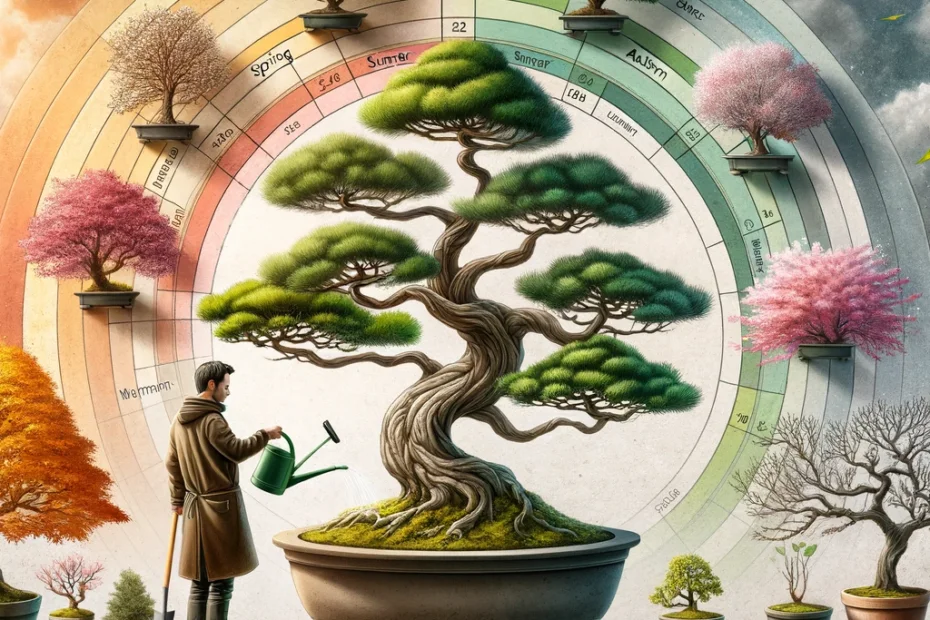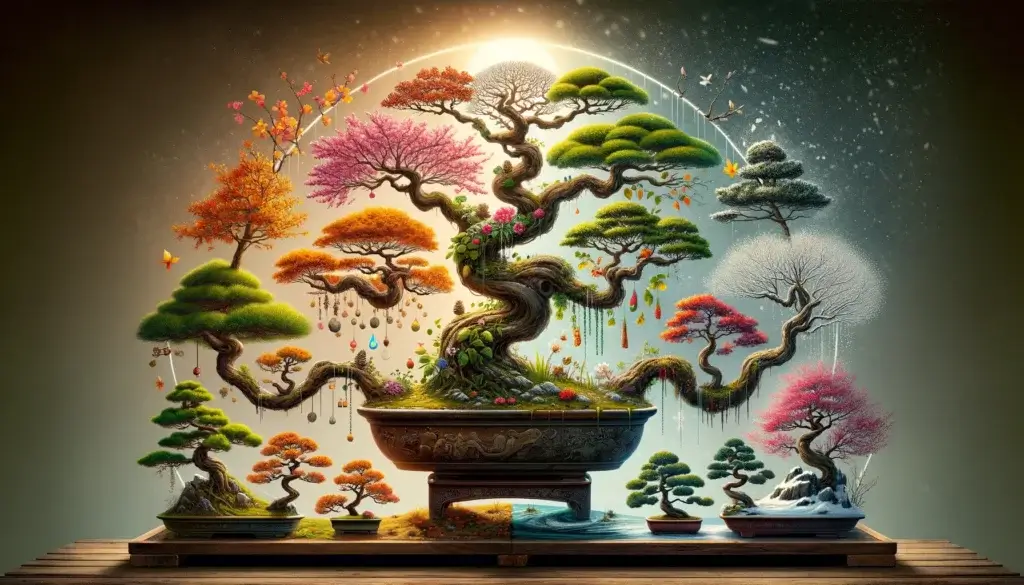
Bonsai, the art of growing miniature trees, is a practice that requires patience, precision, and a deep understanding of nature’s cycles. Mastering bonsai tree care through the seasons involves adapting your care techniques to meet the changing needs of your tree as it navigates the complexities of growth, dormancy, and rejuvenation throughout the year.
This guide provides a season-by-season approach to bonsai care, ensuring your miniature trees remain healthy, vibrant, and aesthetically pleasing all year round.
Understanding Bonsai Basics
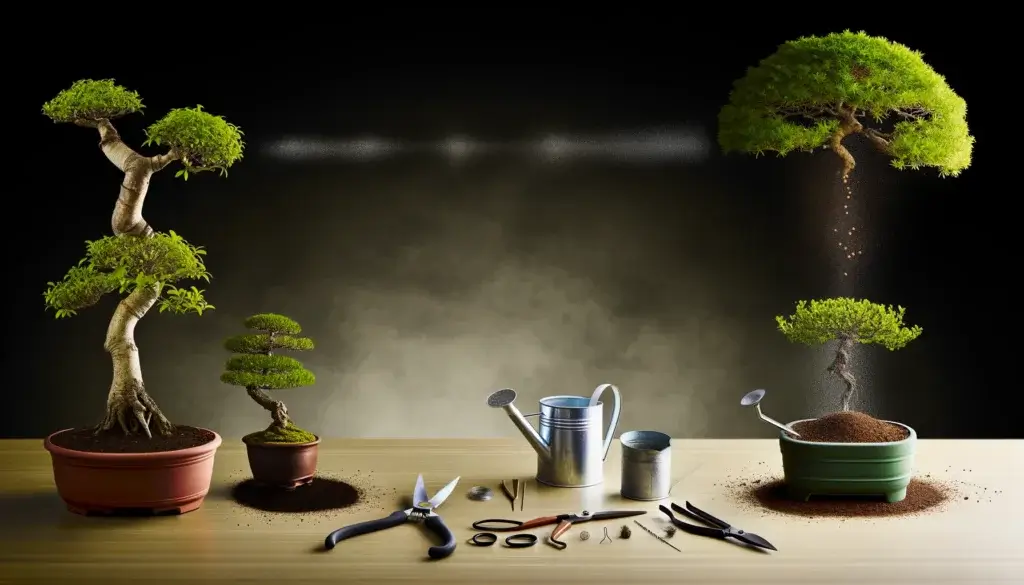
Before diving into seasonal care, it’s crucial to grasp the basics of bonsai. This includes selecting the right tree species for your environment, understanding the fundamental tools required for bonsai care, and recognizing the importance of soil, light, and water in the health of your tree. Each bonsai tree is unique, and its care will depend on its species, age, and the climate it lives in.
Spring Care for Your Bonsai
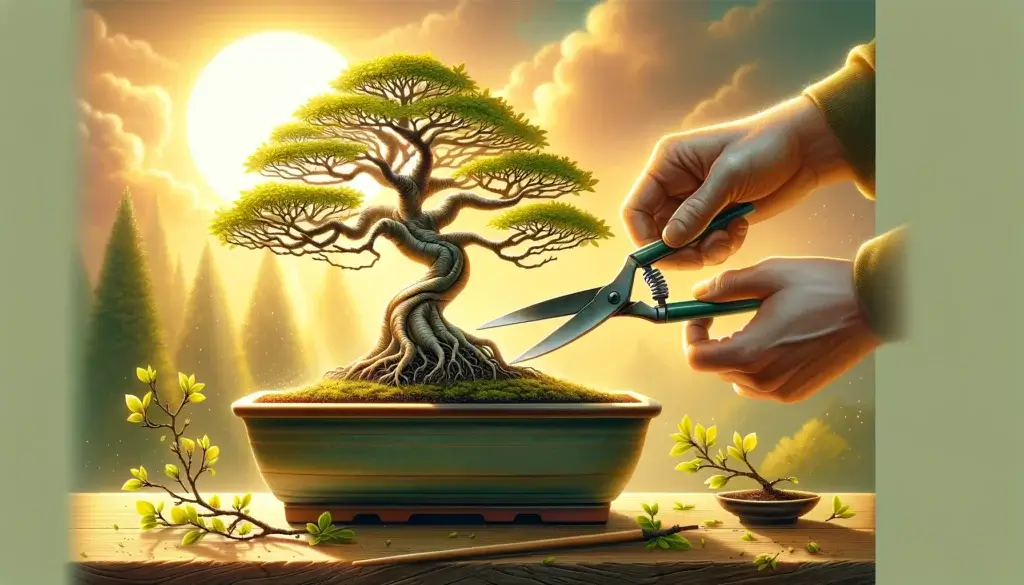
Spring is a time of awakening and growth for bonsai trees. This season calls for attentive pruning to shape the tree and encourage healthy growth. Repotting may also be necessary to provide fresh soil and room for roots to expand. It’s a critical period for setting the tone for the year’s growth, making it essential to monitor your bonsai closely and adjust care as needed.
Summer Maintenance Strategies
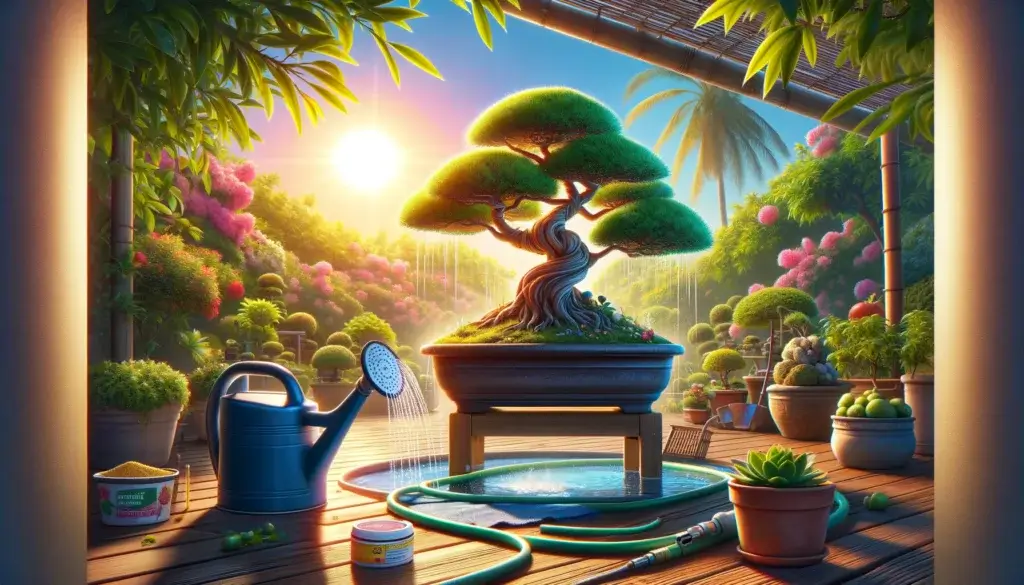
During the hot summer months, your bonsai will require diligent care to prevent stress from heat and ensure it receives adequate water and nutrients. Adjusting watering frequency and fertilizer application to meet the increased metabolic activity of your tree is vital for its health and growth.
Autumn Preparations
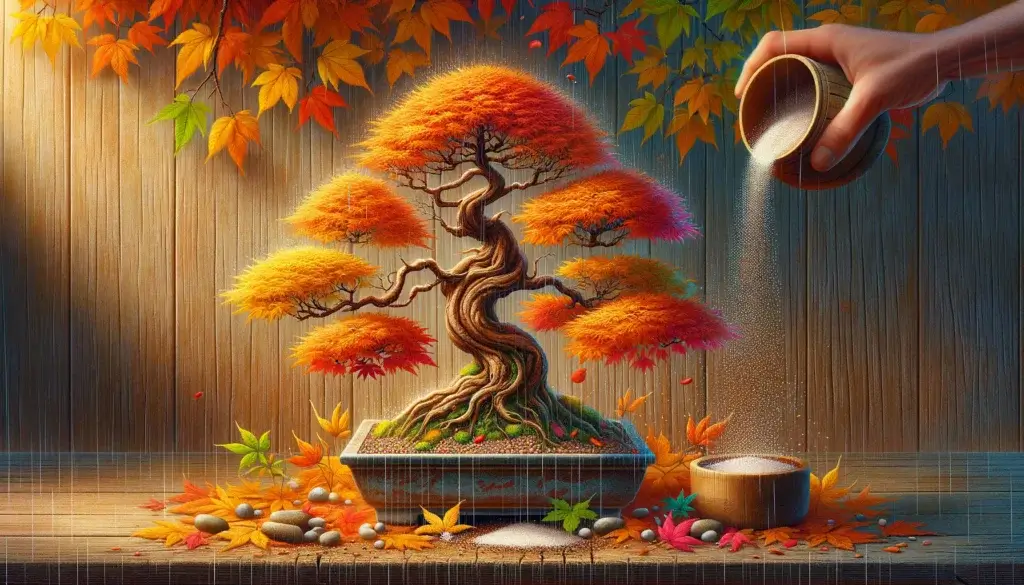
As the season changes to autumn, your bonsai’s needs shift as well. It’s time to prepare your tree for the coming dormancy period. This involves reducing fertilization, adjusting watering, and starting to protect your bonsai from the cooler temperatures ahead.
Winter care varies significantly depending on whether your bonsai is kept indoors or outdoors. For outdoor bonsai, protecting the tree from freezing temperatures is paramount. Indoor bonsai, meanwhile, requires attention to lighting and humidity levels to mimic their natural dormant state as closely as possible.
Pest and Disease Management Across Seasons

Pests and diseases can strike at any time, but with proactive monitoring and the right preventive measures, you can keep your bonsai healthy. Identifying common pests and diseases early and employing effective treatment strategies is crucial to the long-term health of your bonsai.
Fertilization Through the Year
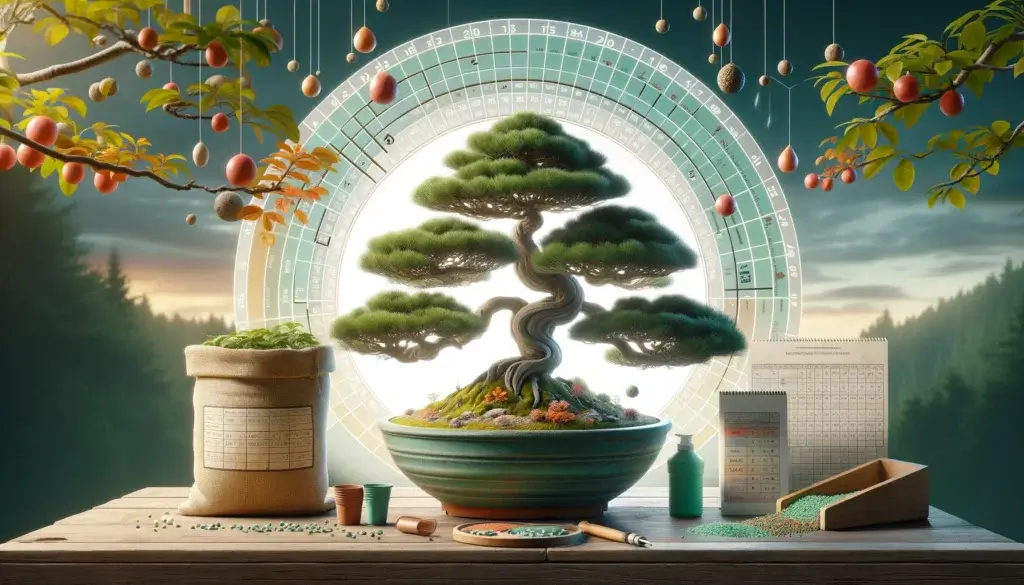
A balanced fertilization regimen is essential for sustaining your bonsai’s growth and vitality. Understanding the nutritional needs of your bonsai and adjusting the fertilization schedule according to the season will support its development and ensure it thrives.
Soil and Watering Techniques

The right soil mixture and effective watering practices are the foundations of healthy bonsai care. Tailoring the soil composition to your specific tree and mastering the art of watering can significantly impact your bonsai’s health and growth.
Bonsai Styling and Shaping Techniques

Styling and shaping are at the heart of bonsai artistry. From basic trimming to advanced wiring techniques, shaping your bonsai is a continuous Bonsai Styling and Shaping Techniques
Bonsai styling and shaping are where creativity meets tradition in the world of bonsai careMastering Bonsai Tree Care Through the Seasons. These techniques allow you to direct the growth of your tree, influencing its form to mimic natural landscapes in miniature. Whether you’re aiming for a windswept look that evokes images of coastal cliffs or a formal upright style that stands with quiet dignity, the key is understanding the principles behind bonsai styling and having the patience to see your vision come to life over time.
Basic Styling Guidelines

Styling starts with observation. Look closely at your bonsai’s natural inclination. Does it lean in a particular direction? Are there branches that naturally lend themselves to a certain style? Once you’ve understood your tree’s natural tendencies, you can begin styling with pruning and wiring.
- Pruning is used to remove unnecessary branches and leaves, helping to create a clear structure that highlights the tree’s best features. Spring is typically the best time for structural pruning, while maintenance pruning can be done throughout the growing season.
- Wiring involves wrapping aluminum or copper wire around branches to gently guide their growth in a desired direction. It’s a delicate process that requires attention to detail to avoid damaging the bark.
Advanced Shaping Methods

For those looking to take their bonsai styling to the next level, advanced techniques such as grafting or creating jin and shari can add unique characteristics to your tree.
- Grafting involves adding new branches or roots from another plant to your bonsai. This can help you achieve a desired shape or improve the tree’s overall health.
- Jin and Shari are techniques used to simulate age and natural wear in trees. Jin refers to the creation of deadwood branches, while shari involves stripping bark to create areas of deadwood along the trunk.
Repotting Essentials

Repotting is a crucial aspect of bonsai care, necessary for maintaining the health of your tree. It provides fresh soil, encourages root growth, and removes excess roots that can crowd the pot and stifle the tree’s growth.
- When and How to Repot: Most bonsai trees need repotting every two to five years, usually in early spring before the growing season begins. The process involves carefully removing the tree from its pot, pruning the roots, and placing it in fresh soil.
- Root Pruning and Soil Renewal: Root pruning is a vital part of repotting. It involves trimming away older, thicker roots to make room for new growth. This helps to keep the tree healthy and maintain its miniature size. After pruning, using a fresh soil mix that suits the specific needs of your bonsai is essential for its health and growth.
Displaying Your Bonsai

The presentation of your bonsai is not just about aesthetics; it’s also about creating the right environment for your tree to thrive. The choice of pot, the stand, and even the background against which your bonsai is displayed can all enhance its beauty and contribute to its health.
- Selecting the Right Location and Display Stand: The location should provide the right balance of light, humidity, and temperature for your bonsai. The display stand, meanwhile, should complement the style of your tree without overshadowing it.
- Seasonal Display Considerations: As the seasons change, so may the optimal display location for your bonsai. Summer might require shading from intense sun, while winter could call for protection from cold drafts. Adjusting your display according to the season is key to maintaining the health of your bonsai.
Mastering Bonsai Tree Care Through the Seasons

Achieving mastery in bonsai care is a lifelong journey that requires patience, observation, and a willingness to learn from both successes and setbacks. Each season brings its own set of challenges and opportunities for growth—both for you and your bonsai. By embracing these cycles and applying the care techniques outlined in this guide, you can enjoy the profound satisfaction that comes from nurturing these living works of art through the seasons.
FAQs
How do I choose the right style for my bonsai? Consider your tree’s natural shape and growth pattern, your personal preferences, and the traditional styles that inspire you. Experimenting with different styles over time can also help you find the right fit for your bonsai.
How often should I water my bonsai in summer? Bonsai trees typically require more frequent watering in summer due to higher temperatures and increased evaporation. Check the soil moisture regularly, and water whenever the top layer feels dry to the touch.
Can I keep my bonsai outside in winter? Some bonsai species can withstand winter outdoors if they are native to your climate. However, tropical and subtropical species will need protection from freezing temperatures and should be brought indoors.
What type of fertilizer is best for bonsai trees? Use a balanced, slow-release fertilizer formulated for bonsai trees. The specific needs may vary based on your tree’s species and the current season.
How do I know when to repot my bonsai? Signs that your bonsai needs repotting include slow growth, water draining slowly through the soil, and roots circling the inside of the pot. Repotting is typically done in early spring.
Why are my bonsai leaves turning yellow? Yellowing leaves can be caused by various factors, including overwatering, under-watering, lack of nutrients, or pests. Assess your care routine and adjust as necessary to address the issue.
Conclusion
The art of bonsai is a reflection of the balance between nature, care, and creativity. By understanding and respecting the needs of your bonsai through each season, you can cultivate not only a beautiful miniature tree but also a deeper appreciation for the natural world. Remember, the journey of bonsai care is one of ongoing learning and discovery. Embrace it with patience and passion, and let it guide you to new heights of gardening mastery.
